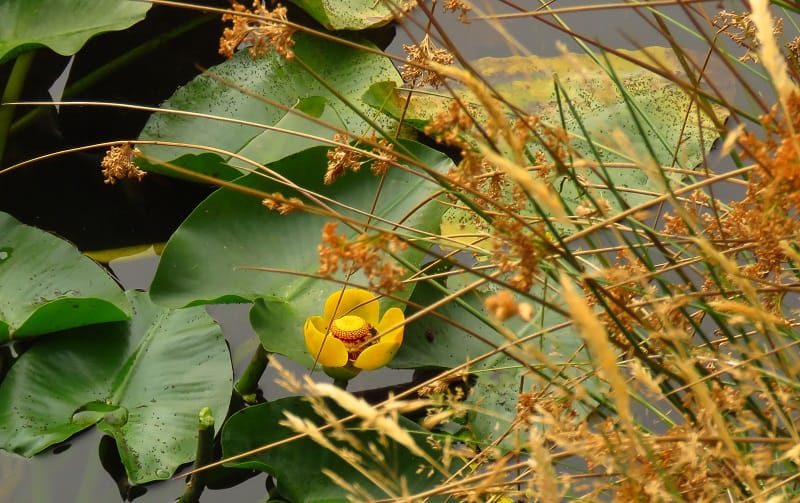W̱MÍYEŦEN Nature Sanctuary
(formerly Mary Lake)
New Ecological Buffer Zone
Help us Plant an Ecological Buffer Zone at the Sanctuary

Restoration Buffer Zone site plan created by Emma Ross of Wilder Restoration
A new subdivision adjacent to the 42-acre sanctuary has impacted the ecosystems along the northeastern border creating both physical, visual and auditory impacts that will also interfere with the present teaching stage area.
The purpose is to create two ecological buffer zones, one along the sanctuary’s property line adjacent to a recent housing development (Ridge line buffer), and the other bordering the driveway to create a sound buffer and wildlife habitat surrounding the presentation/teaching stage area (Stage buffer). The approximate planting area for the Ridge line buffer is about 16,400 sq ft (100m L x 15m W), this area is required to create a dense native plant buffer to mitigate the current and future effects of the housing development on the ecosystems of the Nature Sanctuary. The approximate planting area for the stage buffer is about 3,287sq ft (53m L x 6m W), This area is required to create a buffer of native shrubs between the laneway and the stage area.
Donation Info Below
List of Native Trees, Shrubs and Plants for Site Restoration
All species of trees and plants chosen are indigenous to the bioclimatic zone and therefore adapted to survive.
Forested area along property line: 16,400 sq ft
Species for forested area:
Gaultheria shallon (Salal) – pollinators, birds eat berries, hummingbirds, butterfly adult and larvae.
Pseudotsuga menziesii (Douglas fir) Chickadees, nuthatches, brown creepers, and woodpeckers find insects in the trunk, branches, and twigs. Cavity-nesting birds roost in mature trees. Can live for over a thousand years.
Thuja plicata (Western red cedar) The dense foliage provides important shelter and nest sites for birds. Resource to support plenty of biodiversity including insect species, fungi, rare ferns, and lichen.
Holodiscus discolor (Oceanspray) – pollinators, songbird shelter, butterfly adult and larvae – extremely drought tolerant – fast grower, provides winter forage for insectivorous birds
Lonicera ciliosa (Western Honeysuckle) – pollinators, creates nest areas for small birds.
Buffer area around stage: 3,287 sq ft
Species for buffer area:
Holodiscus discolor (Oceanspray) – pollinators, songbird shelter, butterfly adult and larvae. – extremely drought tolerant – fast grower, provides winter forage for insectivorous birds]
Ribes sanguineum (Red flowering currant) – pollinators, birds eat berries, hummingbirds, butterfly adult and larvae munitum (Sword fern) Shade tolerant understory plant. The fronds may be used as nesting material for rodents. Provide cover for large and small animals.
Physocarpus capitatus (Pacific Ninebark) – pollinators, its flowers are mostly pollinated by native bees but may also be visited by butterflies. Tall arching branches and foliage provides cover.
Cornus sericea (Red Osier Dogwood) – Birds eat fruit, Butterfly adult and larvae – Transplant success is high. Fast growth.
Symphoricarpos (Snowberry)- pollinators – The shrub provides good cover and nesting sites for gamebirds, rabbits, and other small animals.
Philadelphus (Mock orange) – pollinators, birds, butterfly adult and larvae – good erosion control, fast grower.
Rosa gymnocarpa (Baldhip Rose) – pollinators, tolerates seasonal dry. birds, butterfly adult, and larvae, leaf-cutter bee. Provides excellent nesting cover.
Oemleria cerasiformis (June Plum)– pollinators, tolerates seasonal dry. Birds eat berries. Fast grower.
Lonicera ciliosa (Western Honeysuckle) – pollinators, creates nest areas for small birds.
Cost of phase one of the project is approx. $7,000.
This includes mulch, soil, 180 – one and five gallon trees and 182 one gallon shrubs
$20 donation will purchase 1 – five gallon Douglas fir or Western red cedar tree
$35 donation will purchase 3 – one gallon Douglas fir or Western red cedar trees
$50 donation will purchase 7 – one gallon Oceanspray or Pacific Ninebark or Western Honeysuckle or June Plum shrubs
$100 donation will purchase 5 -one gallon Douglas fir or Western red cedar trees and 5 – one gallon Flowering Red Current, or Snowberry or Baldhip Rose or June Plum shrubs
You will receive a downloadable Charitable Tax receipt for each donation of at least $20.
To Donate by Mail
Send us a cheque by mail to:
Greater Victoria Greenbelt Society
1772 Millstream Road, Victoria B.C. V9B 6E4
We will mail you a charitable receipt.
Personal Information – What We’d Like You to Know
“Personal Information” is any information that can be used to identify (or infer the identity of) a specific person, including, for example, your name, address, birth date, gender, etc. In order for us to recognize your gift, it is important to provide the information requested. For example your home address, so we can issue you a charitable receipt, or your email so we can keep you apprised of the impact your contribution is making. By providing personal information to us, you are providing consent for the collection and use of your information.
Please be assured that GVGS does not sell, share or trade your information with any third party.
We respect your right to control your personal information — please email us at [email protected] if you want us to stop contacting you.

New Ecological Buffer Zone will mitigate the impacts of the adjacent subdivision

W̱MÍYEŦEN Nature Sanctuary
1772 Millstream Rd,
Victoria, BC V9B 6E4
W̱MÍYEŦEN Nature Sanctuary Society 1772 Millstream Rd.
Victoria, BC. V9B 6E4
Registered Charity BN: 11894 6953 RR0001
WSÁNEC Coast Salish
W̱MÍYEŦEN Nature Sanctuary lies within the traditional territories of the WSÁNEC (Saanich) Coast Salish Peoples.
We recognize the integral role the ancestors of the WSÁNEC Coast Salish Peoples play as past stewards of the Highlands lands.













